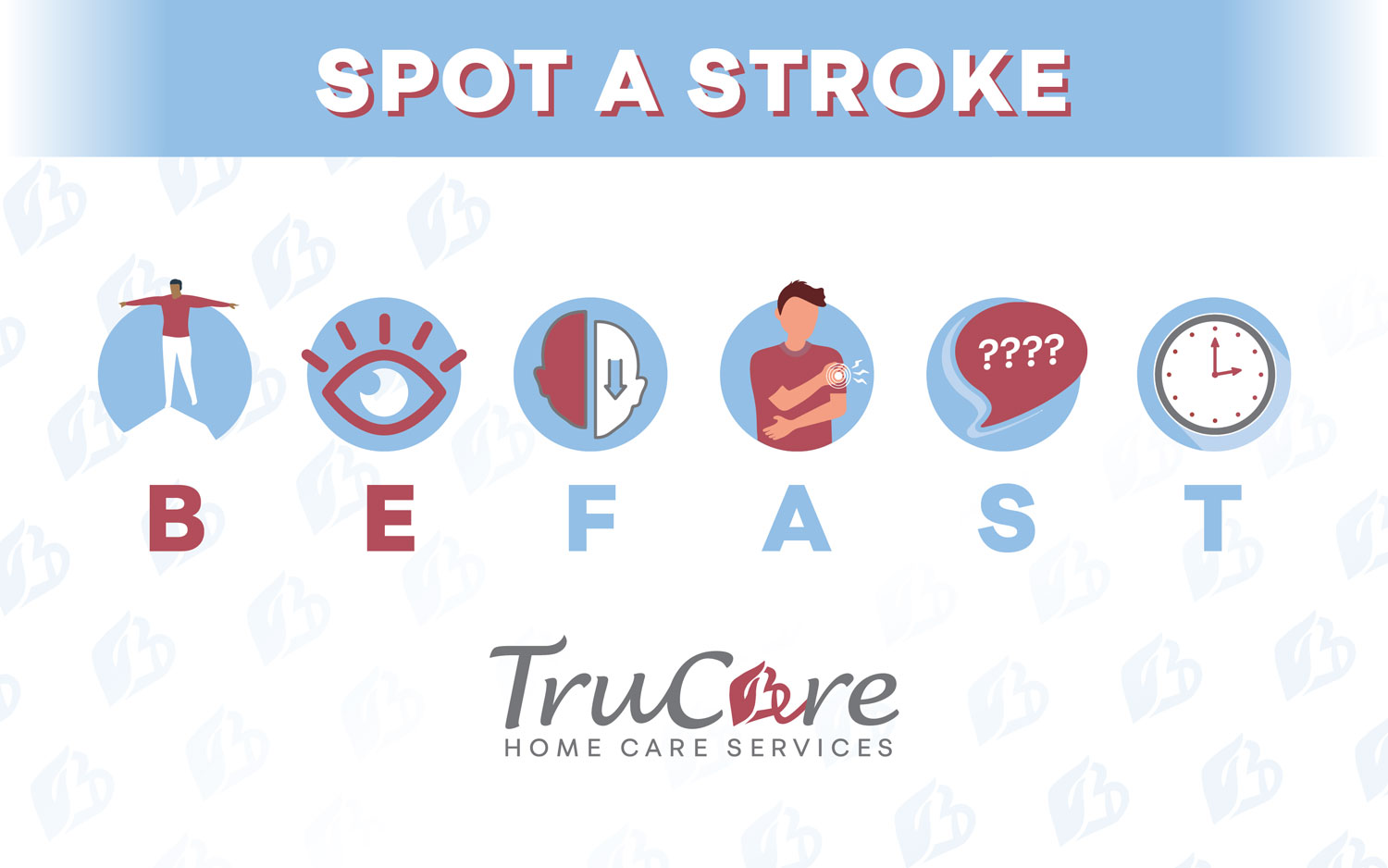How to Prevent Stroke: Know the Signs & Risk Factors

According to the CDC, stroke is the leading cause of death in the nation and “is a major cause of serious disability for adults.” The good news, however, is that stroke is often preventable and can be treated if symptoms are addressed timely. Here’s more information on the signs of stroke and how to help prevent it with healthier lifestyle choices.
What is a Stroke?
A stroke occurs “when something blocks blood supply to a part of the brain or when a blood vessel in the brain bursts.” When the brain is deprived of oxygen-rich blood, brain cells begin to deteriorate, resulting in a stroke. This can lead to brain damage, disability, or death.
What are the Types of Strokes?
Ischemic stroke
The majority of strokes are ischemic strokes, which occur when blood clots or other particles block the blood vessels to the brain. Plaque, fatty deposits, can also cause blockages by building up in the blood vessels.
Hemorrhagic stroke
A hemorrhagic stroke happens when an artery in the brain leaks blood or ruptures. The leaked blood puts too much pressure on brain cells, which damages them. Conditions like high blood pressure and brain aneurysms can cause a hemorrhagic stroke.
Transient Ischemic Attack
A transient ischemic attack (TIA) is sometimes referred to as a “mini-stroke” or “warning stroke” because blood flow to the brain is blocked for a shorter amount of time (generally no more than five minutes). Like ischemic strokes, TIAs are often a result of a blood clot. They can be indicative of a future stroke and should be considered a medical emergency to assess health and prevent a major stroke.
According to the CDC, “More than a third of people who have a TIA and don’t get treatment have a major stroke within 1 year. As many as 10% to 15% of people will have a major stroke within 3 months of a TIA.”
What are the Signs of a Stroke?
Learning the signs of a stroke can help save someone’s life. Quick diagnosis and treatment can reduce brain damage or prevent death. Call 911 immediately if you or anyone else is experiencing any these symptoms:
- Sudden loss of coordination or balance
- Sudden dizziness
- Difficulty walking
- Sudden trouble speaking, understanding speech, or slurred speech
- Severe headache with no known cause
- Facial drooping
- Sudden blurred or loss of vision
- Sudden numbness or weakness in the face, arm, or leg, especially on one side of the body
Consider the acronym BEFAST to keep the signs in mind:
B–Balance – Sudden loss of balance or coordination
E–Eyes – Sudden blurred vision or loss of vision
F–Face Drooping – Sudden facial drooping or numbness
A–Arm – Sudden weak or numb arms or legs on one side of the body
S–Speech – Sudden slurred speech or unable to speak
T–Time – It’s time to call 911 if you’re experiencing any of these symptoms
If you notice you or anyone else is showing these signs, call for an ambulance and document when these signs first began. EMS will be able to begin life-saving treatment on the way to the hospital.
What are the Risk Factors for a Stroke?
While there are some factors beyond control such as family history of strokes or demographics, there are ways to help prevent stroke. Understanding the risk factors can help you take steps to protect yourself and others from an increased risk.
Health Conditions
High Blood Pressure
High blood pressure is the leading cause of stroke. When the pressure of the blood in your arteries and other blood vessels is too high, this can lead to a stroke. Getting your blood pressure checked and taking actions to lower it such as eating well, taking medications, and reducing stress can lower your risk.
High Cholesterol
Cholesterol can build up in the arteries and lead to narrowing of the arteries, stroke, and other health conditions. Your doctor can measure your cholesterol by taking a blood test and work with you to decrease your levels through exercise and a balanced diet.
Heart Disease
Heart disorders such as coronary artery disease increases the risk for stroke due to plaque buildup in the arteries, which blocks the flow of oxygen-rich blood to the brain. “Other heart conditions, such as heart valve defects, irregular heartbeat (including atrial fibrillation), and enlarged heart chambers, can cause blood clots that may break loose and cause a stroke.”
Diabetes
Diabetes increases the risk for stroke because sugars can build up in the blood and prevent oxygen and other nutrients from flowing to the brain. Finding ways to prevent diabetes or to control it through medications, exercise, and dieting can lower your risk.
Obesity
Obesity is often linked to high cholesterol, diabetes, and high blood pressure, which are all individual risk factors for stroke.
Sickle Cell Disease
Sickle cell disease is a “blood disorder linked to ischemic stroke that affects mainly Black children. The disease causes some red blood cells to form an abnormal sickle shape. A stroke can happen if sickle cells get stuck in a blood vessel and block the flow of blood to the brain.”
Lifestyle Choices
Tobacco Use
Using tobacco raises the risk for stroke in a variety of ways. Smoking cigarettes can damage the heart and blood vessels, and carbon monoxide from the smoke can reduce the oxygen in your blood. Also, nicotine raises blood pressure. Even if it’s just second-hand smoke, the exposure can still lead to an increased risk.
Drinking Excessively
According to the CDC, women should have no more than one drink per day, while men should have no more than two drinks per day. Too much alcohol can raise blood pressure as well as the levels of triglycerides, a form of fat in your blood that can harden your arteries.
Limited Exercise
Lack of physical exercise is linked to high blood pressure, high cholesterol, diabetes, and obesity, which are all risks for stroke.
Unhealthy Diet
Eating a diet high in saturated fats, trans fat, and cholesterol has been linked to stroke and related conditions, such as heart disease. Also, getting too much salt (sodium) in the diet can raise blood pressure levels.
Genetics
If you’re aware of a family history of stroke or genetic disorders like sickle cell disease, talk to your doctor about ways to prevent stroke that are within your control such as quitting smoking, exercising more, or eating healthy foods.
Demographics
Age
While younger people can have strokes, the chance of having a stroke doubles roughly every 10 years after age 55. With that being said, “about one in seven strokes occur in adolescents and young adults ages 15 to 49” due to higher rates of obesity, high blood pressure, and diabetes.
Sex
“Stroke is more common in women than men, and women of all ages are more likely than men to die from stroke.” Pregnancy and use of birth control pills also increase risk.
Race or Ethnicity
“People who are Black, Hispanic, American Indian, and Native Alaskan may be more likely to have a stroke than non-Hispanic Whites or Asians. The risk of having a first stroke is nearly twice as high for Blacks as for Whites. Blacks are also more likely to die from stroke than Whites are.”
How Can You Prevent a Stroke?
- Choose healthier foods: Eat foods low in saturated fats, trans fat, and cholesterol, and salt. Make sure to eat fresh vegetables, fruits, and fiber to help lower blood pressure and cholesterol levels.
- Exercise regularly: The CDC recommends 2.5 hours of moderate-intensity aerobic physical activity each week to maintain a healthy weight and reduce risk for high blood pressure and high cholesterol.
- Quit smoking
- Limit alcohol consumption
- Check and maintain cholesterol: Your doctor should test your cholesterol levels at least once every five years. If it’s too high, they can make recommendations to help reduce it.
- Control blood pressure: Check your blood pressure regularly at home, at a pharmacy, or a doctor’s office. Your doctor can help lower your blood pressure through diet, exercise, and medication recommendations.
If you or your senior loved one needs assistance, TruCare Homecare can step in and help. TruCare Homecare is a women-owned and family-operated business centered on providing compassionate in-home senior care in the greater Philadelphia area. Our facility offers adult day care services in addition to home health care services such as meal preparation, grooming, mobility assistance, and transportation.
Caregivers are dedicated to creating meaningful bonds with clients and their families, offering tailored care plans that best benefit individuals’ health care needs. For more information about our services, call our office at 610-878-2273 or fill out a contact form.
References
https://www.eraliving.com/blog/a-guide-to-stroke-awareness-and-prevention/
https://www.cdc.gov/stroke/about.htm
https://www.cdc.gov/stroke/risk_factors.htm
https://www.cdc.gov/stroke/signs_symptoms.htm
https://www.scripps.org/news_items/6067-act-fast-to-stop-a-stroke





